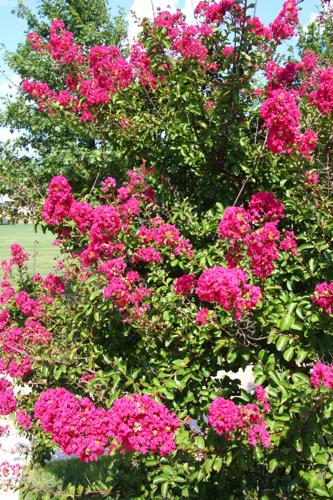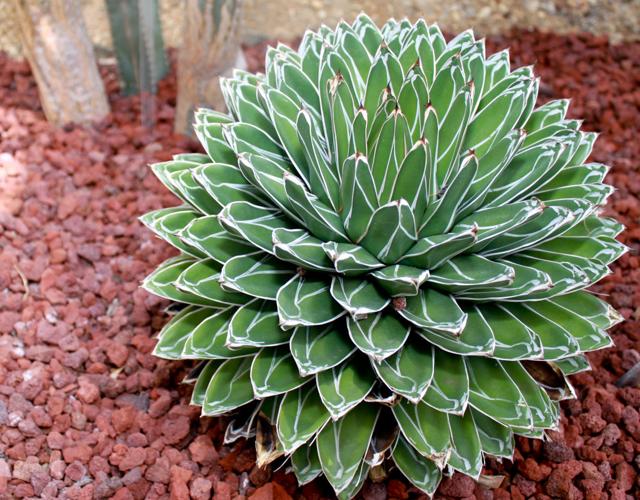Q: Our HOA of 40-plus years has numerous sheared shrubs and we’re trying to renovate and naturalize as many as we can. I hope you can follow up your tree pruning advice with some on the positive approach of hard pruning or rejuvenating some currently sheared, older and overly large Texas rangers and oleanders.
A: Renovating or rejuvenating older, overly large, or previously sheared shrubs extends the life and improves the aesthetic value of these plants. One method is to cut all stems to about 12-18 inches above the ground.
This is a severe measure and changes the appearance drastically, however, when done in early spring before bud burst, causes a great number of stems to grow just below each cut by mid-summer. At that time, about half of the stems should be removed and the remaining ones should be cut back to different heights.
People are also reading…
Varying the height and cutting just above an outward pointing bud will stimulate growth of new branches out of the canopy. According to University of Arizona Horticulture Specialist, Ursula Schuch, this procedure works well for larger fast growing shrubs like Texas ranger and oleander and for slower growing shrubs like hop bush and creosote.
Some shrubs such as cassias, arborvitae, rosemary, and junipers do not respond favorably to this treatment and might die. A less severe approach to rejuvenating shrubs is to remove half or more of the older unproductive branches at the base of the plant or those growing into the canopy. This thins out the plant to a much greater extent than regular maintenance pruning.
Follow-up care requires removing a portion of the new shoots a couple of weeks later, which might be too numerous and result in an overly dense canopy.
A third method of rejuvenation that spans three to four years and is less noticeable requires removing about one third to a quarter of the oldest unproductive branches each year. This method requires thinning excess branches and cutting back the remaining new branches as described before.
A common practice that is not recommended except in the case of formal hedges and topiaries is shearing. Shearing shrubs means cutting back branches to a uniform surface using heading cuts. We see all sorts of examples in our area where shrubs have been sheared to resemble beer can and meatball shapes. It doesn’t just look weird; it’s bad for other reasons.
The maintenance costs for sheared shrubs increases because they require repeat shearing more frequently than they would need regular pruning and they use more water to recover from this harsh treatment. Shearing stresses plants and can result in decline or death.
Q: Please tell me the name of this plant. Also if it blooms, will it then die?
A: This is the Queen Victoria agave (Agave victoriae-reginae). According to Greg Starr in his excellent book called “Agaves”, this is a Chihuahuan Desert species. It grows well throughout our area although it doesn’t do as well in the hot sun of the low desert so planting it in a spot with afternoon shade is a good idea. It is a slow growing species and after 20-25 years it will bloom and then die.
Q: Please tell me how and when to feed and care for crepe myrtle.
A: The crepe myrtle (Lagerstroemia indica) is an interesting woody Asian tree/shrub that grows well throughout the southern US. It does best in a loam/clay soil and needs regular watering.
By this I mean, every 7 to 14 days in the summer to a depth of 24 to 36 inches. In the spring and fall, water every 10 to 21 days and in the winter water every 14 to 21 days.
Fertilization can be done once each spring with a complete fertilizer such as 10-10-10 or you can use organic products such as composted manure. Make sure you water right after you apply the fertilizer.
In any case, a one to two inch layer of bark mulch over the root zone (being careful to keep it away from the trunk) will provide some protection for the roots from hot temperatures and help keep the root zone moist longer.
Some advocate for renovation pruning in the winter (called crepe murder by others) but this is hard on these plants so I recommend minimal pruning to remove dead and broken limbs, crossing and rubbing branches, and shape as needed.
Q: I have Sago and Fan palms with shoots growing out from the base of the plant. Can I remove the shoots and replant them elsewhere? If so, how do I go about removing the shoots?
A: The Sago (Cycas revoluta) is not a true palm, but a cycad. It produces offshoots, sometimes called pups, at the base of the plants. They can be separated using a trowel and transplanted to another location after letting them dry for week or so to seal up the wound.
You might start them in a container in the shade or put some shade cloth over them until they are established if you plant them in the ground. The fan palm shoots are likely growing from seed that fell from nearby trees. These small plants can be moved to other locations by digging them up with the roots and replanting. They typically have small and shallow root systems so it shouldn’t be much trouble while they are young.
Peter L. Warren is the urban horticulture agent for the Pima County Cooperative Extension and the University of Arizona. Questions may be emailed to






